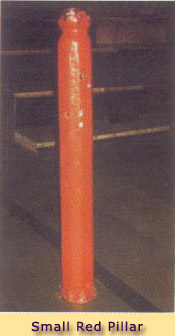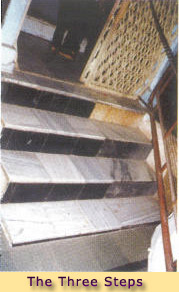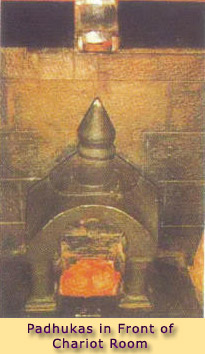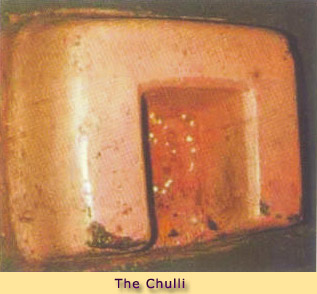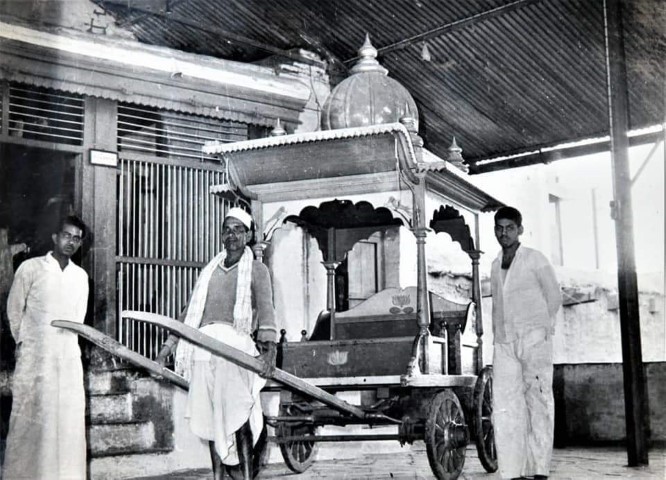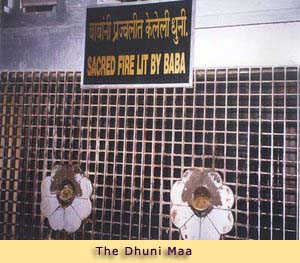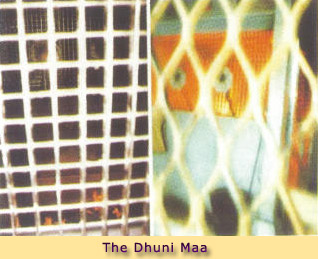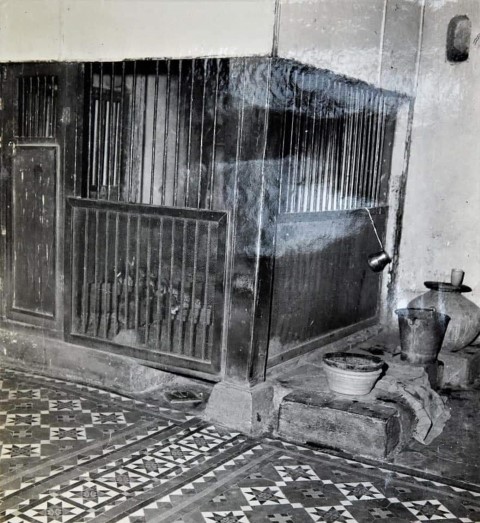DWARAKAMAI (MASJID) |
||
THE BELLThis huge brass bell tied above, and to the left of the entrance of Dwarakamai pavilion was tied by Baba. It is not the original bell and has been changed many times. It is rung only three times a day, at 4.00 AM, 11.30 AM and 8.30 PM. It is rung by the Pujari of the Dwarakamai, calling the devotees for Aarti. If it is rung untimely, it signals an untoward incident has taken place somewhere in the village. The people will assemble in the pavilion, and then go to the place of the calamity and set it right. This practice is still going on; hence its gong is tied to the grill.
Mention is made in Sai Satcharitra Ch.XIX. When Baba sent Hemadpanth (Dhabolkar) to Shyama's house to get Rs.15/- Dakshina, and sit and chit chat with him, Shyama told him the story of Radhabai Deshmukh, and the two paise of Dakshina meaning “Sraddha and Saburi”. Just as Shyama finished the story, the bell of the Masjid started to ring proclaiming that the noon worship and the Aarti had begun and both hurried to the Masjid for the noon Aarti. THE FLAGS (NISHANS) OF THE DWARAKA MAI Gopal Rao Gund was devoted to Baba. He did not have any children, but with Baba’s blessings a son was born to him. He felt that an annual Yatra (fair) should be held in Shirdi. He told the prominent devotees of Shirdi, like Tatya Kote, Dada Patil and Shyama about it. They all liked the idea very much and everyone started making preparations for it. However the Kulkarni (the Revenue Officer) opposed it. Hence the District Collector did not grant them permission to hold the fair. But they single mindedly pursued it, and finally got permission to hold the fair. They chose the festival of Ramanavami to hold the fair. Tatya Kote Patil supervised all the arrangements. Gopal Rao Gund who started the Urs (Ramanavami celebrations) in Shirdi, asked his friend Damu Anna Rasne to supply a flag for the occasion. He also induced Nana Saheb Nimonkar to supply another embroidered flag. Both these flags were taken in procession, through the village to the accompaniment of musical instruments. Then these flags were fixed atop the roof of Dwarakamai. (Ref. ESS, Ch. VI). Even today, this tradition is still being carried out by their descendants. The great grandson of Damu Anna Rasne, Pradeep Rasne brings an ochre coloured flag. He along with his family comes from Ahmednagar. While the great grandson of Nana Sahib Nimonkar, Chandrakant Deshpande Nimonkar brings a green coloured flag from Pune.
Even now the flags brought by the descendants of Damu Anna and Nimonkar are first placed on the Samadhi. Aarti is performed, then taken to the home of Tukaram by the Sansthan. Again Aarti is done, the flags are hoisted on the staff (pole) prepared by the descendants of the three brothers. Then with great joy and ceremony it is taken in procession throughout the village and hoisted on the roof of the Dwarakamai (Ref. Shri Sai Baba of Shirdi by Late Rao Bahadur Moreshwar W Pradhan). The gheru flags on the southern wall of Dwarakamai are provided by the Sansthan. The significance of the Flags or Dhwaja or Nishan The hosting of Flags is a common feature in all Hindu Temples. The Dhwaja or Flag are made of cloth and are hoisted atop temples, taken by Padayatris to holy places like Phandarpur and Shirdi. The temple or place of worship is considered as the palace of deity. He is the emperor of emperors and to honour him the flags are hoisted. Flags denote the area of territory of a particular ruler or a country. Similarly, the flags of the Dwarakamai indicate the place of the Parabramha Shri Samartha Sadguru Shirdi Saibaba. THE SMALL RED PILLAR: The small red pillar is in front of the Chulli. Baba used to sit in front of the Chulli while cooking, and rested his back against this pillar. Whenever Baba went out of the Sanctum Sanctorum, he did Pradakshina to this pillar, and also when he returned. Pradakshina is done of a temple, or a sacred book or a holy tree. A devotee can do the same and get the benefit from this sacred pillar. The unique feature of this pillar is that if anyone who has pain in the back or joints, leans against it, the pain abates. Many a devotee can be seen leaning against it. Some devotees read the Shri Sai Satcharitra, others sing the Aarti leaning against it. Others meditate close to it.
Nana Saheb Dengle was an ardent devotee of Saibaba. Once he wanted to do formal worship to Baba. So he came with all the puja materials and sought Baba’s permission. But, Baba refused and asked him to do the ritual to this pillar. Every morning the Pujari of Dwarakamai applies Asthagandh ( a mixture of sandal wood powder and saffron powder) to this pillar. Now a grill enclosure has been built around it for its preservation. THREE STEPS IN FRONT OF THE PILLARThese three steps on the southern side of the Dwarakamai, were used by Baba to go out and come into the Sanctum Sanctorum. Devotees are requested to offer namaskar to the above steps as Baba used them. The significance of the three steps of the Dwarakamai Mai: The three steps represent the three Gunas. These trigunas refer to three fundamental components of Prakriti or Maya. This is the basic matrix of which this universe is created. These trigunas are Satva, Rajas and Tamas. These gunas are not qualities or attributes, but they are fundamental subtle elements which constitute Prakriti, like the cords of a rope. They bind the jeevatma to the body.
Satva increases when the other two decrease. It is characterized by right knowledge, purity, happiness, and righteous actions, etc. Thus after death, they take us to higher worlds. Rajas, when it increase the other two are low. It provides a thirst for selfish actions, anger, greed, lust, involvement, suffering, and egoism. After death it brings the Jeeva back to earth. Tamas increases when the other two are low. It is characterized by ignorance, dullness, sloth and sin. After death the jeeva goes to the lower worlds. To reach the Parabrahma one has to be gunatita. This is possible by doing sadhana, under the tutelage of the Sadguru. But for his grace this is next to impossible. Therefore, one has to rise above the trigunas to establish the pure Satva or “Self”. This can be accomplished by treating the pair of opposites with equanimity, by remaining unconcerned about losses or gains etc. i.e., by remaining calmly aloof, and above all being totally surrendered to him. Thereby, one by climbing the three steps of the Dwarakamai will reach the state of attributeless Parabrahma. PADUKAS IN FRONT OF CHARIOT ROOMEvery morning Baba stood here leaning against the wall, while He looked at the sun. In remembrance of this, two sets of Padukas; (1) small Padukas are on the southern wall. This is where Baba placed His hand while leaning against the wall; and (2) just below the small Padukas, is a small shrine enclosing a bigger set of Padukas. This is the site of Baba's holy charan (sacred feet).
Daily worship is done by the Pujari of Dwarakamai with ashtagandh.
THE CHULLI The Chulli is a semicircular earthen hearth or oven. Small faggots of wood are placed in its cavity and lit, while the Handi or Utensil is placed on top of the rim. This Chulli is directly in front of the red pillar, in the Sabhamandap. The Shastras prescribe charity for all the woes of the Kali Yuga. Of all forms of charity, Anna Daan is the highest, as every one feels the pangs of hunger. As Baba took a Saguna Roopa, he also did Anna Daan. Whenever Baba wanted to do Anna Daan He used this Chulli for preparing the food, and the devotees joyfully ate the Prasad. There were two copper Handies, a smaller one could feed 50 people. The other could feed a hundred people to satiation with some food remaining.
When Baba decided to cook He was very meticulous about the salt, condiments, garnishing and other ingredients. He would go to the grocer, and the market place, and buy exactly what was required and paid in cash. He himself ground the wheat, pulses or jowari on the quern, and then prepared the food. Baba would often prepare meatha chawal, mutton pulav (spicy rice with bits of mutton in it), varan (soup like lentil or dal) with wheat dumplings or Moong daal dumplings and ambli. Often times instead of a ladle He would pull up the sleeve of His Kafni and churn the contents with his bare hands. Yet there was no trace of burns or scalding on His hands. After the food was cooked to his satisfaction He would carry it to the Masjid (sanctum sanctorum) of Dwarakamai. The Maulvi would offer Fatiah or prayers, to the food with proper ritual. Then Baba would send the Prasad to homes of Mahalsapathi and Tathya. The remaining food, Baba served the people assembled there to their utmost satisfaction. "Have some more, take some more" He lovingly said (ESS, Ch.XXXVIII). These Quern (hand mill) and the handies used by Baba, are now kept in the Museum. THE CHARIOT (RATH) ROOM This room is on the left side, of the main entrance to Dwarakamai. The old chariot used to be kept in it. This chariot was presented to Baba by Avasthi and Rege. The first procession was taken on Gurupurnima of 1918. The devotees entreated Baba for permission and Baba reluctantly agreed to the procession. But Baba never sat in this chariot. On festival days, the Rath is taken in procession around the village. Previously, Sivanesan Swamiji , an ardent devotee of Baba, who with his tireless efforts cleaned and beautified the Dwarakamai, was allotted this room by the Sansthan and he stayed in this room for many years. Later this room was used to store containers of hot Udi before it was sieved. The chariot was then taken and kept in the extension of the Samadhi Mandir. Now, the right wall has small trap doors so the Udi is shoveled directly into trays from the Dhuni Maa.
The Old Chariot (Photo Courtesy: Shri.Nandakumar Revannath Deshpande Nimonkar) The rest of the room is used to store sacks of Gowri (Cow Dug Cakes) and logs of wood to feed the Dhuni Maa. The Chariot was kept for sometime in the extension of the Samadhi Mandir. After the Museum was built this only original rath which is from Baba’s time has been housed in the hall on the ground floor of the Museum. THE DHUNI MAA The everlasting Dhuni lit by Baba Himself more than 150 years ago, is still burning. The word 'Dhuni' possibly comes from the root word 'Dhun' meaning 'to kindle or waft'. Even during the cholera epidemic, when the Panchayats ordained that no fuel cart should be allowed to come in the village, Baba went to the fuel cart and bought wood for his Dhuni. Baba went at regular intervals to the forest nearby and carried huge logs of wood for his Dhuni. The smoke and soot that emitted from the Dhuni Maa and touched or covered the devotees seated there was akin to Bhasma Snan. Like an Agnihotri, keeping his sacred fire alive, throughout his life Baba kept this Dhuni ever burning all day and night (Ref. ESS, XXIII).
Old Picture of Dhuni Maa (Photo Courtesy: Shri.Nandakumar Revannath Deshpande Nimonkar) When Baba slept in the Chavadi, Radhakrishna Aai cleaned, and whitewashed the Masjid. She had to take out all the things including the Dhuni and replace it as it was (Ref. ESS, Ch. VI). At first Baba practiced medicine and became famous as a Hakim. Later He stopped giving medicines, but gave Udi instead. Baba's all omnipresence and mercy saved the blacksmith's child from a horrible death in the furnace. On Shyama's concern, and questioning Baba replied "When the child slipped into the furnace, I immediately thrust my hand and saved the child. I do not mind my arm being burnt, but I ain glad that the life of the child is saved". What intense mercy and love for His Bhaktas! This incident bestowed Baba's favour on Bhagoji Shinde, who daily massaged and bandaged it till Baba's Mahasamadhi (Ref. ESS, Ch. VII). Every morning Baba sat in front of this Dhuni. He seemed to be offering into the Dhuni oblations of the ego, desires, and all thoughts. 'Allah Mallik', 'Allah Mallik' He softly said (Ref. ESS, Ch.V). Sitting by the Dhuni Baba often spoke of the distant places He went to overnight and what He had done. Those who slept by His side the whole night at the Dwarakamai knew that His physical body was in Shirdi. But these statements were occasionally verified and found to be true by Prof. Narke and also others (Ref: Devotees Experiences of Saibaba). The Dhuni is 7’ long and 5’2’’ wide. The masonary walls running from South to North have a wooden pilar incorporated into it on both the sides. There is an iron door that is opened to offer the fuel. The iron door often gets jammed from the intense heat, yet these wooden pillars are neither charred, nor wrapped, nor burnt. The Poojari or Sevakaris of the Sansthan have to stand astride in the corner while cleaning the Dhuni from the inside. This is done very often to prevent soot building up. Yet, not one of them has burnt feet or efen has redness of the soles. Dhuni Mai looks after and protects Her wards and Her children. Devotees offer wood, gowri, ghee, nav dhanya and five types of wood to this sacred Dhuni. In the early days, the Dhuni Puja was done by the individual devotee. But, now with the heavy turnout of devotees from all over the world to Shirdi, the Dhuni puja cannot be done by the individual devotees as the Dhuni is boarded with a mesh. This is a precaution taken by the Sansthan in order to preserve Dhuni Maa’s sanctity, as devotees used to put the loban along with the plastic wrapper, and other undesirable articles to the sacred fire. A huge drum is placed near the Dhuni to enable devotees to place their offerings in it and it is later offered to the Dhuni by the priest. The Dhuni Puja is done daily between 11.30 a.m. and 12.00 noon by the Sansthan. Eleven coconuts, wood, gowri are offered to Dhuni Maa at this time. The priest from the Samadhi Mandir does Vaishva Deva (Agni) Puja with Anna Ahuti (cooked rice mixed with ghee), as was done during Baba’s time by Sagun Meru Naik upon Baba's instructions. In our daily lives we kill a lot of insects, flies and mosquitoes, thus accumulating a lot of sins. To get ablution from these sins we should feed, the agni, the ants with sugar, feed the dog, the crow and the cow. It is often impossible to do this and hence Baba in his mercy did this for us. The Sansthan is doing it for us every day by performing the Vaishva Deva Puja. The Udhi is kept in a stainless steel container corrodes it, yet the devotees ingest it daily only to get beneficial results. An interesting incident narrated by Sai Mahabhakta Shivaneshan Swamiji is worth mentioning here: In 1974, a group of Russian scientists were shocked to see the Dhuni bellowing lot of smoke. They wanted to test it for pollution and brought various gadgets and meters. They placed their instruments in all directions but only minimal counts of carbon monoxide, sulphur dioxide, etc., were recorded. They could not believe their eyes. Then they took the same materials like wood, gowri, loban etc., to their laboratories to check the counts after burning them and found that they were exceedingly high. Finally they returned to the Dwarakamai and bowed to Dhuni Mai accepting Her divine power. As Shivaneshan Swamiji had full faith in the power of Dhuni Mai, he confidentally asked the Russian Scientists to check all they wanted! |
||
(Courtesy: Ambrosia in Shirdi and Baba’s Gurukul by Vinny Chitluri). |
||
© 2011 Saiamrithadhara.com. All Rights Reserved. |


